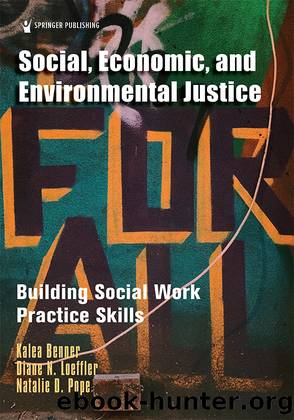Social, Economic, and Environmental Justice by unknow

Author:unknow
Language: eng
Format: epub
Tags: Social Science, Social Work, Political Science, Public Policy, Social Policy, Human Rights
ISBN: 9780826135391
Google: QUoUEAAAQBAJ
Publisher: Springer Publishing Company
Published: 2021-05-13T04:24:56+00:00
Mrs. Bailey is an example of how the elderly may be particularly vulnerable to the effects of a disaster, with health and behavioral health consequences in addition to concerns regarding transportation, mobility, safety, and security. We will return to the narrative of Mrs. Bailey later in our discussion. Next, let us consider how the experience of disasters may be different for a poor family.
Impoverished Families
Socioeconomic status (i.e., social class) is typically defined as a location in the social and economic hierarchy that reflects a combination of income status, educational attainment, and occupational prestige (Kraus et al., 2017). Social class can also include the presence of social capital, which refers to resources (e.g., information, influence, financial capital, emotional support) available through a personâs networks (Manstead, 2018; Pitkin Derose & Varda, 2009). While multiple social classes may characterize an individual during their lifetime, socioeconomic status often has long-lasting effects on peopleâs personal and social identity. Class influences a personâs thoughts, emotions, and behaviors in response to social environment (Dorius, 2018; DuPont et al., 2015; Kraus et al., 2017; Manstead, 2018). For example, evidence suggests that individuals with lower income are less likely to invest in rentersâ or homeownersâ insurance (Insurance Information Institute, 2019), which most certainly would affect their ability to recover from a natural disaster.
Families with limited income typically struggle to prepare for, respond to, and recover from disasters (Brown, 2008; SAMHSA, 2017). Not surprisingly, because they lack financial resources, these families are not likely to have extra food or supplies on hand when a disaster hits. They may also have inadequate resources, such as a personally owned vehicle or money to pay for travel, to evacuate when needed. Like older adults, people of low socioeconomic status will be less prepared for disasters, unable to respond to official warnings about disasters, and more vulnerable to adversity during the recovery phase (Al-Rousan et al., 2014; Fothergill & Peek, 2004; SAMHSA, 2017). As mentioned, families with limited income may be unable to afford sufficient insurance that would support them in rebuilding their homes following a disaster. The inability to rebuild increases their risk of homelessness or dislocation (Brown, 2008; SAMHSA, 2017). Losses that cannot be replaced can cause families extreme distress and feelings of hopelessness (U.S. Department of Health and Human Services [DHHS], 2003; SAMHSA, 2017).
Download
This site does not store any files on its server. We only index and link to content provided by other sites. Please contact the content providers to delete copyright contents if any and email us, we'll remove relevant links or contents immediately.
The Secret History by Donna Tartt(18242)
The Social Justice Warrior Handbook by Lisa De Pasquale(11964)
Thirteen Reasons Why by Jay Asher(8478)
This Is How You Lose Her by Junot Diaz(6465)
Weapons of Math Destruction by Cathy O'Neil(5862)
Zero to One by Peter Thiel(5510)
Beartown by Fredrik Backman(5374)
The Myth of the Strong Leader by Archie Brown(5251)
The Fire Next Time by James Baldwin(5034)
How Democracies Die by Steven Levitsky & Daniel Ziblatt(4973)
Promise Me, Dad by Joe Biden(4916)
Stone's Rules by Roger Stone(4876)
100 Deadly Skills by Clint Emerson(4705)
A Higher Loyalty: Truth, Lies, and Leadership by James Comey(4569)
Rise and Kill First by Ronen Bergman(4554)
Secrecy World by Jake Bernstein(4410)
The David Icke Guide to the Global Conspiracy (and how to end it) by David Icke(4401)
The Farm by Tom Rob Smith(4334)
The Doomsday Machine by Daniel Ellsberg(4254)
